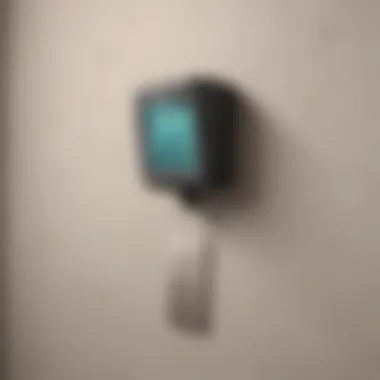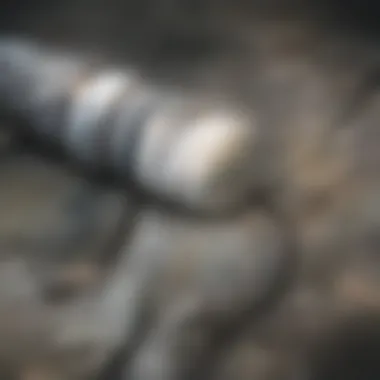The Definitive Guide to Finding a Stud in Your Home


Intro
Finding studs in your walls is a key component of successful home improvement projects. Knowing where to locate these structural supports can transform your space, allowing for secure installations of heavy items like shelves or televisions. In this guide, we will explore the methods to identify studs accurately, whether you are a DIY enthusiast or a seasoned homemaker. This knowledge not only boosts your confidence in tackling projects but also safeguards your investments against potential damage.
Studs are typically spaced either 16 or 24 inches apart in most homes. However, layout can vary based on architectural designs that prioritize functionality and strength. Therefore, understanding how to locate these hidden structures is crucial. We will cover various techniques, from traditional methods to the use of modern stud finders, and everything in between.
As you read through this guide, you will gain insights that arm you with practical tips and a checklist of tools that make stud locating easy and accurate. Let’s start by diving into the fascinating world of architectural designs where understanding the layout of your home becomes essential before any transformation.
Understanding the Importance of Studs in Home Improvement
Finding the right location of studs is fundamental to various home improvement tasks. When installing shelves, televisions, or artwork, knowing where studs are located can prevent costly mistakes. The strength and safety of structures often depend on proper stud placement. By understanding studs, you enhance your ability to create secure and lasting installations.
Definition of a Stud
A stud is a vertical framing member in a wall that provides support to the load of the structure. They are typically made from wood or metal and are spaced at regular intervals throughout the walls of a building. Generally, the standard spacing is either 16 or 24 inches apart. This regularity serves as a guideline for where nails or screws can securely attach fixtures.
Role of Studs in Structural Integrity
Studs play a crucial role in maintaining the structural integrity of a building. They bear much of the weight from ceilings and roofs, distributing it to the foundation. This distribution helps prevent sagging or collapsing. Without properly located and installed studs, walls can become weak, leading to potential hazards such as cracks or complete failure of sections of the wall. Understanding where these elements are situated helps ensure that any renovations or installations enhance the overall safety of the home.
Common Uses of Studs in Renovation Projects
In renovation projects, studs act as vital reference points for various tasks, including:
- Mounting heavy fixtures: Items such as televisions or large artwork require secure attachment, which only studs can provide.
- Installing shelves and cabinets: Proper anchoring is essential to prevent accidents or damage to the items themselves.
- Hanging drywall: Studs give a framework for attaching new wall materials, ensuring that they remain stable and secure over time.
The importance of knowing how to find studs cannot be overstated. Properly located studs facilitate safe and efficient renovation projects, yielding both aesthetic and functional benefits.
Traditional Methods for Finding Studs
Traditional methods for finding studs provide fundamental techniques for homeowners and DIY enthusiasts. Although modern tools exist, understanding these classic approaches can be critical. They give insight into basic principles of wall structures, improving technique proficiency. These methods do not rely on expensive devices, making them accessible.
Tapping Technique
The tapping technique is a straightforward, effective method for locating studs. To perform the tapping method, gently knock on the wall with your knuckles. Listen closely for changes in sound. When you tap on a stud, the sound is solid, while the hollow area between studs generates a different tone.
How to Perform the Tapping Method
To perform the tapping method, begin by selecting a mid-height area on the wall. Fingertips or knuckles are ideal for this task. Tap lightly and then listen carefully. The stud will produce a distinct sound compared to the void in the wall. This method is advantageous due to its simplicity and low cost. No special tools are required, making it a popular choice among DIYers.
Sound Differences in Wall Panels
Understanding sound differences in wall panels is crucial for effectively using the tapping technique. Each type of wall surface, such as drywall or plywood, can affect how sound travels. Typically, the sound from a stud will resonate clearly, while a hollow area emits a dull echo. This property allows users to distinguish between different sections of the wall easily. Understanding these sound characteristics enhances the effectiveness of the tapping method and provides a reliable way to locate studs.
Measuring from Corners
Measuring from corners is another time-tested method for finding studs. The majority of residential construction follows a consistent stud spacing configuration. This technique involves using a tape measure starting from either the left or right corner of the wall. From this point, you typically measure 16 or 24 inches.
Standard Stud Spacing
Stud spacing refers to the distance between two adjacent studs. The most common spacing is 16 inches or 24 inches apart, depending on the construction method. Standard stud spacing provides homeowners a solid basis for estimations when trying to locate a stud. However, variations can exist based on home age or renovations.
Limitations of Measuring
Despite its benefits, there are limitations to the measuring method. Not all homes adhere to the standard spacing. Older structures may have irregularities in stud placement. Also, obstructions such as electrical wiring can confuse the measuring process. This inconsistency may hinder locating studs with complete accuracy. Therefore, this method often works best when combined with other techniques for higher reliability.
Modern Tools for Locating Studs


As home improvement tasks evolve, so do the tools designed to facilitate these processes. Modern tools for locating studs represent a significant advancement over traditional methods. These tools offer accuracy and ease, addressing the common frustrations that come with locating hidden support structures in walls. The growing popularity of electronic and magnetic stud finders showcases the demand for efficiency in DIY projects. Both types of tools provide homeowners with reliable means to identify stud locations with less effort and more precision.
Electronic Stud Finders
Types of Electronic Stud Finders
Electronic stud finders can be categorized into two main types: capacitance-based and deep scanning. Capacitance-based devices work by measuring changes in electrical capacitance when a stud is detected behind a wall. They are lightweight and easy to use, making them a common choice for everyday users. Deep scanning stud finders are more advanced, enabling detection through thicker wall materials like plaster or wallboard. This distinction is crucial for those undertaking more complex projects. The versatility of various types makes electronic stud finders beneficial since they adapt well to different home improvement needs.
Advantages and Disadvantages
One key advantage of electronic stud finders is their accuracy. They can provide precise readings, making it easier to locate the center of a stud. This is essential for hanging heavy items safely. However, they do have disadvantages too. For instance, they can be affected by other elements in the wall, such as metal furring strips or electrical wiring. Plus, some models require battery power, which introduces the potential for running out of power mid-project. Thus, while they offer substantial benefits, users need to be aware of their limitations.
Magnetic Stud Finders
How Magnetic Stud Finders Work
Magnetic stud finders operate using small magnets to detect the nails or screws that fasten drywall to wooden studs. This process is simpler than that of electronic finders and does not require power, which makes them reliable for quick checks. Their effectiveness lies in locating ferromagnetic materials, which keeps them appealing to many DIY enthusiasts. However, the effectiveness can vary depending on the stud’s depth and the wall’s material composition.
Effectiveness in Various Wall Types
Magnetic stud finders are generally effective in standard wall types, such as drywall. They may face challenges with thicker or denser materials, like plaster or concrete walls. This means that though they are straightforward and cost-effective, there are limitations to their use in complicated wall structures. Users may find them less effective if attempting to locate studs in insulated or wired walls. Understanding these nuances ensures that homeowners choose the right tool tailored for their specific renovation project.
"The choice between electronic and magnetic stud finders largely depends on the nature of the task at hand and the materials involved."
How to Use a Stud Finder Effectively
Using a stud finder properly is crucial for ensuring successful installation projects within your home. A stud finder helps locate wooden and metal studs behind walls, which is essential when hanging items securely. Effectively utilizing this tool can save time and prevent damage to walls. Being familiar with techniques can enhance your DIY experience, making you more efficient and confident in your home improvement endeavors.
Preparing the Area
Removing Obstacles
Clearing the workspace is key when using a stud finder. Removing obstacles, like furniture or wall decorations, is vital for an accurate reading. This action allows you to access the area directly and minimizes interference. One significant characteristic of this step is its simplicity; a clutter-free space enhances focus and accuracy. Prioritizing an unobstructed area reduces distractions, making it easier to pinpoint stud locations.
Benefits: By removing obstacles, you ensure that the stud finder detects signals without interference. The clear space provides better visual confirmation of wall features, increasing the reliability of your findings.
Clearing Wall Residues
Clearing wall residues from dust, adhesive, or paint is another important aspect. Residue can cause the device to read incorrectly. Ensuring the wall is clean directly impacts the effectiveness of the reader. A clean surface allows the sensor to function optimally. This step should not be overlooked, as even minor smudges can lead to inaccurate detection.
Unique Features: A key feature of clearing wall residues is that it not only ensures accuracy but also prepares the surface for potential fastenings. Thus, it prevents any extra work in correcting mistakes after hanging items.
Calibrating the Device
Calibrating the device is necessary to achieve the best results with a stud finder. A well-calibrated tool will enhance your success rate in identifying stud locations. This simple step involves starting the stud finder according to the manufacturer's instructions, which generally involves pressing a button or turning it on. A characteristic benefit of proper calibration is increased accuracy, ensuring reliable stud detection.
Steps for Calibration
The steps for calibration typically include placing the device flat against the wall and activating it. This adjustment allows the unit to set its baseline readings based on the wall's composition. One distinctive advantage of taking this step is that it prevents false positives when searching for studs. By ensuring proper setup, you effectively reduce the chance of misdirection during your project.
Common Calibration Mistakes
Mistakes during calibration can lead to undesired results. It is a common issue when users skip necessary steps or misunderstand the device's requirements. An essential characteristic of identifying these common errors is that awareness beforehand can save you time. Recognizing calibration mistakes can prevent frustration and lost opportunities for accurate stud location.
Unique Features: Understanding common calibration errors enhances your overall approach to using these tools, allowing for smoother operations in the future. Each miscalibration can serve as a learning experience, improving skills over time.
Reading the Results
Effectively reading the results from the stud finder is central to ensuring successful installations. Accurately interpreting findings becomes essential when deciding where to place fasteners. A clear understanding of results will increase confidence in your work and overall success.


Identifying Stud Locations
Correctly identifying stud locations requires careful observation of the device's signals, often indicated by lights or sounds. This identification process can be greatly influenced by how well the device was prepared and calibrated. An important aspect of pinpointing stud locations is knowing that each stud finder may provide different signals and feedback.
Benefits: Using the device consistently in the same manner will allow you to understand its readings fully, improving your skills in real-time. Identifying stud positions accurately protects against potential damage from errors, ensuring items are hung securely.
Verifying Findings
After identifying a potential stud location, verifying findings is crucial. This process often includes using the stud finder again in the same area to confirm its readings. You may also want to make small test holes to check stud presence if possible. This step allows for an even higher level of certainty.
Unique Features: Verification not only increases the accuracy of your project but also serves as a quality check in your work. Misplaced hanging can lead to deeper issues down the line, such as damaged walls or failed installations.
Alternative Methods and Tips
Alternative methods and tips for finding studs are crucial for homeowners engaging in DIY projects. While traditional tools and techniques provide a solid foundation, exploring these alternatives can enhance accuracy and simplify the process of locating studs. Utilizing diverse methods allows you to adapt your strategy based on individual circumstances, such as wall type or available tools.
Using a Strong Magnet
Using a strong magnet is a practical and cost-effective method for locating studs. This technique relies on the metal screws or nails attached to the wooden studs, which are usually installed throughout the wall to support drywall.
Procedure for Magnet Use
- Get a Strong Magnet: Opt for a neodymium magnet because of its strong pulling power.
- Move the Magnet Across the Wall: Slowly glide the magnet horizontally along the surface of the wall.
- Stop When You Feel Pull: The magnet will stick to the wall when it encounters a metal fastener belonging to a stud. Mark the location with a pencil.
The procedure for magnet use is beneficial due to its simplicity. It's an effective choice when electronic devices are unavailable or when users prefer low-tech solutions. The magnet provides the ability to check larger areas at once, reducing time spent on pinpointing studs.
Pros and Cons of this Technique
Pros:
- Cost-effective: This method requires little to no investment, making it accessible for all homeowners.
- Accuracy: Directly identifies areas where screws or nails are present.
Cons:
- Limited Detection: It may struggle with deeper-set screws or walls with additional features.
- Metal Only: This method will fail on walls without metal fasteners, restricting its usefulness in some contexts.
Looking for Wall Outlets and Light Switches
Another insightful technique for locating studs involves observing wall outlets and light switches. These fixtures are generally mounted on the side of a stud, which can serve as a reliable indicator when searching for stud locations.
Traces of Studs Near Outlets
By identifying wall outlets, you can determine stud placement more accurately. Most outlets are fastened directly to the side of a stud.
- Check the Layout: Outlets are typically spaced every 16 to 24 inches apart, aligning with stud locations.
- Measure from the Outlet: Once an outlet is located, measure 16 inches to the left or right for the next stud.
The traces of studs near outlets method is a practical approach. It takes advantage of existing structures, offering a clear map of where studs might be located without extra tools.
Wall Fixtures as Indicators
In addition to outlets, light switches can also provide valuable insights into stud placement. Since switches are ideally installed into walls where supporting structures exist, they can serve as effective indicators of stud locations.
- Align Measurements: Similar to outlets, use the distance from a switch to arrive at probable stud locations.
- Consider Height: Switches are generally mounted on an average height, making their alignment consistent across interiors.
Utilizing wall fixtures as indicators is a wise tactic. It allows for a quick assessment of stud placement with familiar elements already present in the home. However, as with any technique, it may not work in all scenarios depending on the configuration of the walls.
In summary, these alternative methods emphasize resourcefulness and practicality, enabling anyone to improve their DIY skills. Whether through magnets or recognizing the layout around electrical features, each method contributes valuable knowledge for effectively finding studs.


Challenges in Finding Studs
Understanding the challenges in locating studs can greatly enhance your home improvement endeavors. Various factors can complicate stud detection, making it essential for anyone engaging in DIY projects to be aware of these issues. Challenges reflect both the nature of the materials used in walls and common mistakes that can lead to misjudgments. This section will delve into specific issues like the variability of wall materials and the errors one might encounter during the process.
Wall Material Variability
Stud Location in Different Wall Types
Finding studs is not always straightforward. The material of the wall can have a significant impact on where studs are located and how easily they can be found.
Different wall types, such as drywall, plaster, and lath, have unique characteristics. For instance, drywall is commonly used in many homes and typically has a predictable stud layout, making stud searching relatively easier. In contrast, plaster walls may require more skill and patience since they may not follow standard stud spacing. This variability can lead to difficulties in accurately locating studs, which is essential for safely mounting items.
The key characteristic of this challenge lies in the construction method of the walls. Different homes may have different standards and techniques. For DIY enthusiasts, knowing how material influences stud alignment is crucial. Therefore, understanding the layout of your specific wall type can avoid frustration during a home improvement project.
Effects of Insulation and Wiring
Another vital factor in locating studs is the presence of insulation and wiring. Insulation can obscure the location of studs, particularly in walls designed for energy efficiency. When insulation fills spaces between studs, it may mask the physical markers that one would usually rely on.
The layout of electrical wiring further complicates the situation. Wires are often placed parallel to wall studs but can also be located within the same space. Knowing where wiring happens may guide identifying stud locations but also creates a risk of mistakes.
From a technical perspective, understanding how insulation and wiring impact stud detection is beneficial. Misjudging these elements can lead to anchoring options that are not secure or even potentially hazardous. Therefore, a careful assessment of the wall composition and its associated elements is important for a successful renovation.
Mistakes to Avoid
Being aware of common pitfalls is just as crucial as knowing what tools and techniques to use. Misinterpreting the information that comes from your methods of stud finding can lead to unnecessary frustration.
Common Misinterpretations
Misinterpretations can frequently arise when using electronic stud finders. Many users mistakenly take readings at face value without verifying against other methods. This results in mounting items in less secure locations, exposing them to risk.
In addition, one might assume that the stud's location is consistent throughout the wall. Standard spacing is common but not universal. Therefore, understanding that each wall may have its own layout is critical for accurate stud finding.
The unique feature of these common misinterpretations is that they stem from insufficient knowledge or experience. Paying closer attention to the signs and ensuring proper validation of tools can significantly improve outcomes in stud locating efforts.
How to Correct Errors
To correct errors in stud finding, it is vital to engage in a follow-up process after making an initial identification. Using multiple methods, such as tapping and magnet techniques, can help confirm findings before making any permanent attachments.
Another significant aspect is being adaptable. Adjusting techniques to the specific wall types can offer better results. For users finding that their assumptions led them astray, assessing the wall type and applying new strategies can effectively correct the path taken.
Ultimately, avoiding serious mistakes in stud identification revolves around proper validation of findings and adapting techniques according to wall characteristics.
Closure
The conclusion serves as a vital component of this article, encapsulating the central themes and insights into finding studs in your home. Understanding how to locate studs is not just an exercise in practicality; it is fundamental for the success of various home improvement projects. From mounting shelves to securing large appliances, accurate stud identification enhances both safety and aesthetics of your interiors.
In this article, we delved into the significance of studs. We examined the methods used historically and the modern tools now available. The discussion also highlighted the various challenges, such as wall material variability and common mistakes, giving readers the right context in which to apply their knowledge.
The benefits of mastering stud location techniques extend beyond mere convenience. Completing projects effectively boosts confidence and encourages a sense of accomplishment. Furthermore, it emphasizes the importance of careful planning and execution, which can lead to more satisfying outcomes.
Accurate stud detection is essential for ensuring secure installation, preventing damage to walls, and preserving the integrity of electrical systems.
This guide also serves as a reminder that home improvement is an endeavor that many can undertake successfully, provided they possess the right information and tools. Making informed decisions about either traditional techniques or modern devices can set the groundwork for a rewarding DIY experience.
Summary of Key Points
- The structural importance of studs is clear; they support various fixtures on walls.
- Traditional methods, like the tapping technique and measuring from corners, still hold value today.
- Modern tools such as electronic and magnetic stud finders provide alternatives that can simplify the process.
- Identifying studs accurately ensures both safety and aesthetics in home improvement projects.
- Understanding common pitfalls can help avoid costly mistakes.
Encouragement for DIY Projects
For those who have yet to embark on a DIY project, this guide serves as your initiation. The ability to find studs accurately empowers you to take on tasks that enhance your living space. Whether you are hanging art, installing shelving, or mounting televisions, these skills are invaluable.
Starting with simpler projects can build confidence, allowing you to tackle more complex tasks over time. Remember that trial and error is part of the learning process. Each project can offer insight that prepares you for the next one.
Entering the realm of home improvement can be enjoyable and rewarding. With patience and practice, finding studs will become second nature, leading to a more fulfilling experience when enhancing your home.















